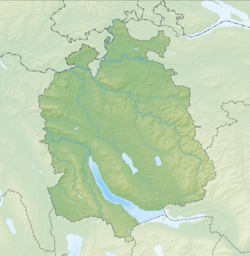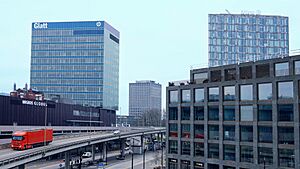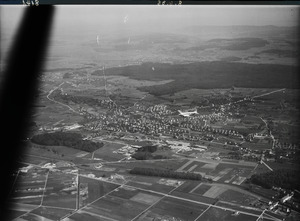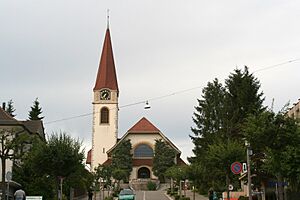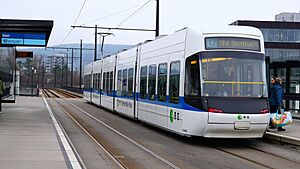Wallisellen facts for kids
Quick facts for kids
Wallisellen
|
||
|---|---|---|
 |
||
|
||
| Country | Switzerland | |
| Canton | Zürich | |
| District | Bülach | |
| Area | ||
| • Total | 6.42 km2 (2.48 sq mi) | |
| Elevation | 431 m (1,414 ft) | |
| Population
(Dec 2020 )
|
||
| • Total | 17,218 | |
| • Density | 2,681.9/km2 (6,946/sq mi) | |
| Postal code |
8304
|
|
| Surrounded by | Dietlikon, Dübendorf, Kloten, Opfikon, Zürich | |
| Twin towns | Rolle (Switzerland) | |
Wallisellen is a town in Switzerland. It is located in the canton of Zürich, within the Bülach district. Wallisellen is part of the Glatt Valley, a region known for its modern developments.
Contents
A Look at Wallisellen's Past
People first settled in the Wallisellen area around 58 BC. The town of Wallisellen as we know it today began to form between 400 and 700 BC. This was after a time when many different groups of people moved across Europe.
The name "Wallisellen" comes from two old words: "Walchen" and "Seller." The Germanic people used "Walchen" to describe their Celtic and Roman neighbors. "Seller" meant farmers who had recently moved to the area, unlike those who had lived there for a long time. Experts believe the name "Wallisellen" was given by Franks or Alemanni to a small farm settlement. This settlement was likely started or lived in by Celts or Romans.
A big change happened on June 25, 1856. The Swiss Northeastern Railway opened a line connecting Zürich, Wallisellen, and Winterthur. This was Wallisellen's first link to Switzerland's railway system.
In 1916, the nearby town of Rieden joined with Wallisellen. Between World War I and World War II, Wallisellen grew from a small village into a busy suburb of Zurich. However, it chose not to become a city at that time.
During World War II, Wallisellen helped with the "cultivation battle." This was a national effort to grow more food at home. It was important because less food could be imported from other countries.
In 1958, the Roman Catholic church of St. Antonius was built in Wallisellen.
Wallisellen's Location and Land
Wallisellen covers an area of about 6.5 square kilometers (2.5 square miles). A good portion of this land, about 23.8%, is used for farming. Forests cover another 20.1% of the area. Most of the land, 54.5%, is developed with buildings and roads. A small part, 1.5%, is made up of rivers or other natural areas.
People and Community
As of 2022, Wallisellen has a population of 17,299 people. In 2007, about 25.5% of the people living in Wallisellen were from other countries. Over the past ten years, the town's population has grown by 11.8%.
Most people in Wallisellen speak German (83.2%). Italian is the second most common language (3.8%), followed by Serbo-Croatian (1.9%).
In the 2007 election, the most popular political group was the SVP. They received 38.6% of the votes. Other popular parties included the SPS (19%) and the FDP (15.4%).
Looking at the age of the population in 2000:
- Children and teenagers (0–19 years old) made up 19.1%.
- Adults (20–64 years old) made up 64.4%.
- Seniors (over 64 years old) made up 16.5%.
About 76.9% of adults in Wallisellen (aged 25-64) have completed higher education. This includes university or specialized colleges.
Wallisellen has an unemployment rate of 3.21%. In 2005, there were 50 people working in farming. There were also 3,085 people working in manufacturing and industry. The largest number of workers, 8,950, were in the service sector. This sector includes jobs like retail, healthcare, and education.
Wallisellen's Economy
Wallisellen is home to the large Shopping Center Glatt, also known as Glattzentrum. This indoor shopping mall first opened its doors in 1975.
Near the Wallisellen railway station is Richti Shopping. This is an outdoor shopping center that opened in stages, finishing by the end of 2014.
Many big international companies have their Swiss headquarters in Wallisellen. These include well-known names like Microsoft, Cisco, Ford Motor Company, UPC Switzerland, and NCR.
Getting Around Wallisellen
Wallisellen Bahnhof is a key transport hub. It is a stop for the Zürich S-Bahn train lines S8, S14, and S19. It is also part of the Stadtbahn Glattal light rail system.
The Line 12 tram serves Wallisellen. It has five stops within the town: Wallisellen Herti, Wallisellen Belair, Wallisellen Bahnhof, Wallisellen Glatt, and Wallisellen Neugut.
Places to See in Wallisellen
- Reformed Church
- Doctorhouse
- Shopping Center Glatt (Glattzentrum)
- Tower of Rieden
- Boulder Nature Trail
- Nature Reserve "Moos"
- Holzers Home "Holz Hütte"
- Holzers Castle "Holzers Schloss"
Sports and Clubs
Wallisellen has many active sports clubs and associations. The biggest sports club is FC Wallisellen, which is a football (soccer) club. In the 2006-2007 season, their first team moved up to the 2nd league.
Other successful sports clubs include:
- EHC Wallisellen (Ice hockey club)
- Faustball Wallisellen (Fistball club)
The TV Wallisellen (Gymnastic club) is also very active. Since 1993, this club has organized the Walliseller Lauf (Run of Wallisellen). All the money raised from this event goes to help children who are battling cancer.
Wallisellen also has two scout troops: Gryfensee and Winkelried.
Language and Local Rhyme
Wallisellen is known in the German-speaking part of Switzerland because of a fun rhyme. It goes: "Aazelle, Bölle schelle, d'Chatz gaht uf Walliselle, chunnt si wider hei, hät si chrummi Bei, piff paff puff und du bisch (ehr und redlich) duss."
Here's what it means in English: "Counting, peeling onions, the cat goes to Wallisellen, comes she back home, has she crooked legs, piff paff and you are (honestly and candidly) outside."
A song by the Bernese dialect band Stiller Has is also called "Walliselle."
Today, most people in Wallisellen speak a mix of Swiss German dialects. It's a kind of Zurich-German that has also taken in some words and sounds from standard German. Long-time residents can often tell the difference by how the town's name, Wallisellen, is pronounced, especially the "s" sound.
Famous People from Wallisellen
- Anton Trieb (1883 – 1954 in Wallisellen), a talented artist who created watercolors, illustrations, and graphic designs.
- Charles Rathgeb (1897–1988), a soldier and an honorary citizen of Wallisellen.
- Kurt Wüthrich (born 1938), a chemist who won the Nobel Prize in Chemistry.
- Beat Fehr (1943 in Wallisellen – 1967), a racing car driver.
- Adrian Naef (born 1948), a Swiss writer and musician who grew up in Wallisellen.
- Pierangelo Boog (born 1957), a graphic designer, illustrator, and artist who lives in Wallisellen.
- Daniel Rohr (born 1960), an actor, director, and theater manager.
- Jacqueline Fehr (born 1963 in Wallisellen), a politician who serves on the Swiss National Council.
- Sven Ninnemann (born 1974), a German professional dancer.
- Fabienne Liechti (born 1978), a professional ballroom dancer and choreographer based in Los Angeles.
- Sven Riederer (born 1981), a triathlon athlete who won a bronze medal at the 2004 Summer Olympics. He is also a Swiss champion.
- Pius Suter (born 1996), an ice hockey player for the ZSC Lions. He was the PostFinance Top Scorer in the National League in 2019-20.
See also
 In Spanish: Wallisellen para niños
In Spanish: Wallisellen para niños




